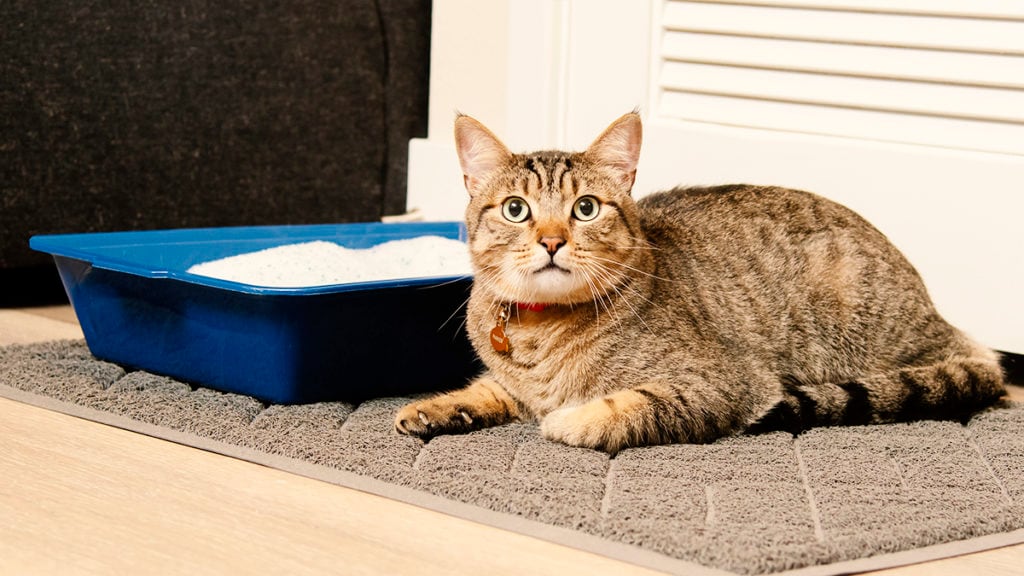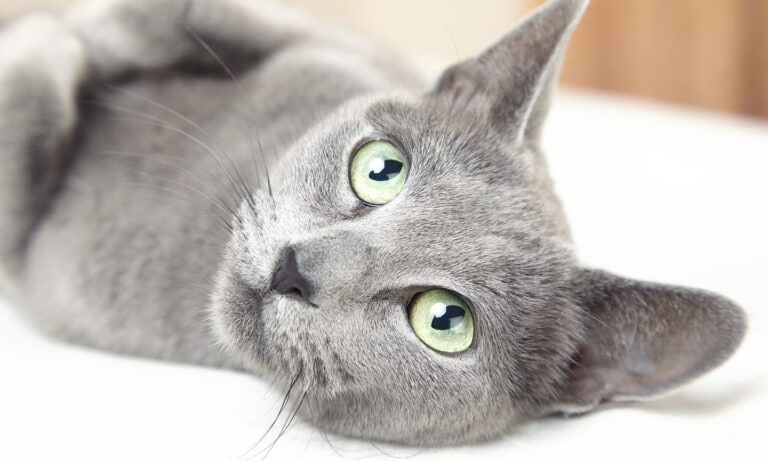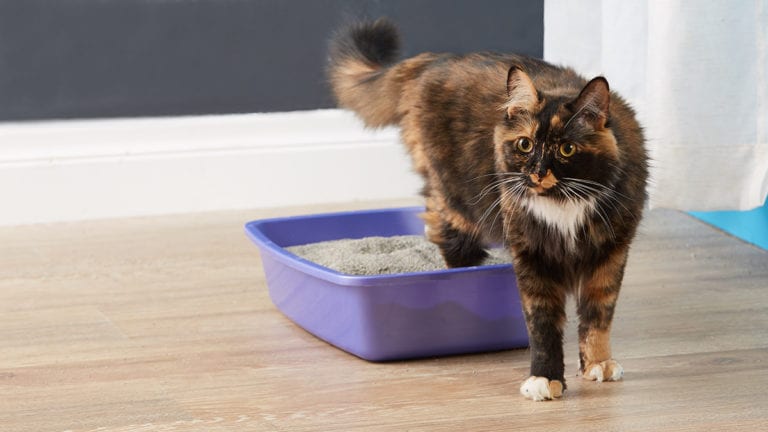A kitty with a cat litter box issue isn’t subtle. Finding an accident in your house is an unmistakable sign that your cat isn’t too pleased with her litter box situation. How to fix the problem, however, isn’t always so obvious.
One of the first steps in solving a cat litter box problem is to consider your cat’s life stage. Causes for little box problems often are tied to the cat’s age.
First and foremost, however, confirm that there is not a medical reason your cat is not using her litter box properly. Take her to a veterinarian for a full exam, fecal analysis and urinalysis—particularly if your cat is a senior.
Kitten Stage
Fortunately, kittens usually are very easy to potty train. This group also is often the easiest to sort out, especially since they have not developed bad “habits” yet. Here are the top three problems and solutions for kitten litter box problems.
1. The litter pan is too big.
Although adult cats prefer a large box, kittens can struggle getting over the lip of the litter pan, particularly if it is designed for a full-sized feline. There are litter pans specifically designed for kittens and small cats, and they are likely the ideal “starter box” for kittens who might be too short to make it in easily when nature calls.
2. The litter pan is too far away.
A tiny kitten means a tiny bladder—and lots of trips to the cat litter box. If your kitten has to travel very far, she might not get enough warning to make it into the box.
Keeping young kittens confined to a small area containing a litter pan is one solution to this problem. Another effective solution is providing multiple pans in an area so the kitten is always near an acceptable place to go.
3. Kitty just doesn’t yet know where to go.
If you have a very young kitten, she may have not associated the litter pan with the place to “go” yet. Placing a small amount of your kitten’s stool in the spot where you want her kitten to eliminate and showing her the soiled box is usually all it takes to give her the idea.
Note: NEVER rub a feline’s nose in an accident. This teaches the cat nothing, causes a lot of stress for the cat, and in all, is a lose-lose scenario.
Get more tips for litter training kittens.
Adult Cat Stage
Adult cats are the ones we most commonly see not using the litter box, so if that is your cat’s life stage, you are not alone! There are several reasons cats eliminate in unauthorized areas—and these do not include being “mad” or “spiteful.” These are the top three problems and solutions of adult cats.
1. Your cat prefers a different box.
Some cats prefer an uncovered box while others prefer a covered one. Because of this, some behaviorists recommend offering a “buffet.” Give your cat a choice of several different kinds of litter boxes to discover her preference.
2. There aren’t enough boxes for the number of cats.
As a rule, provide one more cat litter box than the number of cats in your home. So, one cat needs two boxes. Two cats? Three boxes. Three cats? Four boxes, and so on. This even counts if you have a litter of kittens, although they often will “share” nicely.
Cats frequently will urinate in one box and defecate in another. Owning multiple boxes to choose from allows your cats flexibility in their options.
3. The box is not kept clean enough.
This is the No. 1 reason cats eliminate outside their litter boxes. Think of a Porta-Potty; we don’t like to use a toilet that hasn’t been flushed in multiple uses or is holding odors from the previous occupant. Neither do cats.
Ideally, scooping a box 2-3 times per day works for most cats. Once a week, completely dump the cat litter box contents, wash and dry the pan and refill it with fresh litter. If odor is a problem, you can try an odor-control cat litter.
If you’re away from home a lot, consider an automatic litter box. An automatic litter box can be programmed to self-clean after your cat has used it, which might help get rid of odors and keep the pan pristine.
When traveling with cats, a disposable litter box is an easy answer to clean up without the hassle. A disposable litter box usually lasts for a few weeks at a time before you need to get rid of it.
Get more tips for litter training an adult cat.
Senior Cat Stage
If your kitty is a senior, orthopedic and medical reasons can come into play with litter box issues. A cat who is over the age of 7 who stops using the litter pan most likely is experiencing a medical issue instead of a behavioral one and should visit the veterinarian immediately.
However, medical and behavioral problems can start to blend in this age category. For example, if arthritis makes it difficult to enter the cat litter box, she might pick a nearby spot instead.
Below are the top issues senior cats face as well as their special needs.
1. Something spooked the cat while using the box.
Older kitties start to lose their hearing and/or vision, which sometimes makes them easily spooked. If something or someone startles a senior cat in the loo, she may decide it is unsafe to return. Even if the source really is not scary—a truck backfiring nearby, the washer suddenly turning on or being ambushed by another cat—your cat kitty might blame the litter pan for the issue and refuse to use it going forward.
In that case, simply moving the cat litter pan can resolve the issue. As well, discuss with your veterinarian any medical issues that might make your cat edgy.
2. The box is the wrong size and shape.
Senior cats may experience trouble climbing over the lip of the box. You can easily fix the challenge by cutting the side down for access, purchasing a “puppy” litter pan or finding one designed specifically for senior cats.
Sometimes older kitties are too arthritic to arch their backs while urinating and will stand in the box but spray urine over the edge. Using a taller box with one side cut very low often solves this problem, as does using a longer box that is more likely to catch the urine. Another tip is to place dog potty pads on the ground around litter boxes to catch any “spillover.”
3. The box is placed in a hard-to-reach location.
We all are inclined to put the cat litter box in a hidden or discrete spot, such as the basement or the guest room closet. When your senior friend has to go, however, she might not want to climb three flights of stairs or navigate around the stuff stored in the basement to go pee. Also, kitty might be caught short and not have time to traverse the entire house.
Senior cats might not feel up to a long walk each time nature calls, particularly if they have arthritis. Instead, place litter pans in convenient and easy-to-reach spots.
Get more tips for litter training senior cats.
Before implementing any of the suggestions above for any life stage, confirm that there is not a medical reason your cat is not using her litter box properly. No amount of litter pan wrangling will solve a medical issue, which is likely to get worse over time. Rule out health problems right out of the gate, and then you can focus on any necessary changes to the litter set up.
It can be complicated business to satisfy your cat’s litter pan desires. However, if kitty has stopped using a litter box, nothing you can do will change her mind except treating underlying medical problems and making the pan an acceptable place to go again. So, put on our Sherlock Holmes hat and let’s get kitty back into the potty!

Dr. Sandra Mitchell is a graduate of the New York State College of Veterinary Medicine. She enjoys working with all animals, whether they be cats, dogs, rats, ferrets, guinea pigs or an even wild creatures. She currently works as a relief veterinarian—meaning that she help out at other veterinary offices when a doctor needs to go on vacation—and teaches both veterinarians and veterinary students.
Featured Image: By Jon Lofdahl
Share:










